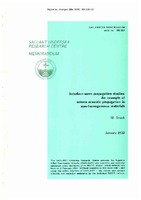| dc.contributor.author | Snoek, Michael | |
| dc.date.accessioned | 2018-10-11T14:06:04Z | |
| dc.date.available | 2018-10-11T14:06:04Z | |
| dc.date.issued | 1990/01 | |
| dc.identifier | 1707 | |
| dc.identifier.govdoc | SM-229 | |
| dc.identifier.uri | http://hdl.handle.net/20.500.12489/194 | |
| dc.description.abstract | This study addresses the problem relating to the interaction processes | |
| dc.description.abstract | of the seismo-acoustic wavefield with the seafloor and sub-seafloor. Particular attention is devoted to an understanding and an explanation of the experimental problems involved with the generation, propagation and recording of interface waves. These seismic waves propagate at very low frequencies (2-20 Hz) and are further characterized by being polarized in the source/receiver plane (sagittal plane). It is shown that the propagation of these waves is very sensitive to material inhomogeneities. This fact, however, allows one to estimate material characteristics from propagation variations. Triaxial ocean bottom seismometers (OBS) are used to study these phenomena in situ. The results of this experiment are given and the effects of material parameters on seismic propagation are demonstrated. The SACLANTCEN SAFARI code was used to model the dispersion behaviour of the interface waves. The results of the calculations are discussed. | |
| dc.format | vi, 39 p. : ill. ; 19 fig. | |
| dc.language | English | |
| dc.publisher | NATO. SACLANTCEN | |
| dc.relation.ispartofseries | ADB144316 | |
| dc.subject | Seismo-acoustic propagation | |
| dc.subject | Seismo-acoustics | |
| dc.subject | Seafloor | |
| dc.subject | Shear waves | |
| dc.title | Interface-wave propagation studies: an example of seismo-acoustic propagation in non-homogeneous materials | |
| dc.type | Scientific Memorandum (SM) | |
